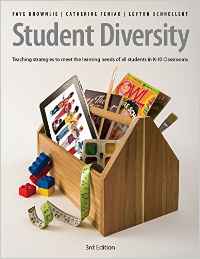| ________________
CM . . .
. Volume XXIII Number 23. . . February 24, 2017
excerpt:
This third edition of Student Diversity: Teaching Strategies to Meet the Learning Needs of All Students in K-10 Classrooms, by Brownlie, Feniak and Schnellert, is an inspiring guide to encourage teacher collaboration and best practice to support all learners in the classroom. While the recommendation here is made for the upper elementary grades, the authors have done a great job in providing examples applicable to tailoring the strategies to early childhood and primary level classrooms as well. An example of this is the “Working Together: Writing in Kindergarten” section in Chapter 5. This increase in emphasis is a change from the second edition (2006) which focussed more heavily on strategies in the upper elementary grades. However, the content of the book has more to do with one’s pedagogical approaches to learning and inclusion in the classroom, rather than specific curricular connections. Each chapter examines different ways to apply the strategies discussed. The introduction and Chapter 1 explain the foundation and philosophy of the instruction model. Chapter 2 discusses the importance of formative assessment in reference to reading assessments. Chapter 3 introduces the philosophical approach, such as getting to know students and designing lessons, behind the strategies presented in the remainder of the book. Chapter 4 focusses on the foundations of a Writers Workshop; Chapter 5 is about narrative writing; Chapter 6 examines another approach to the classroom novel; Chapter 7 reviews the essentials as well as extensions for the literature circle, and Chapter 8 presents invitations to poetry practice. Chapters 9 through 11 integrate examples from social studies, science and mathematics. This edition weaves in strategies and practical examples from the primary level, which is a change from the second edition. As well, the issuing of the 2007 McKinsey report, How the World’s Best-Performing School Systems Come Out on Top and the follow-up 2010 report, How the World’s Most Improved School Systems Keep Getting Better, have both informed the writing of this third edition of Student Diversity, with their focus on the importance of improving instruction and collaborative practice to support all learners. The model presented is one of reflection, interaction and collaboration, with tools to engage and meet the learning needs of all students in the classroom. It is predicated on the concept of a classroom teacher and resource teacher working hand in hand within the classroom. Brownlie, Feniak and Schnellert provide reasoning behind why pulling students out of the classroom to work with them has a negative impact on building a supportive classroom community “where students respect one another and value diversity” (p. 13). The collaborative nature of the model in not unlike what is presently happening in Ontario schools with Math Resource Specialists coming into classrooms to support math learning and working closely with classroom teachers. The resource teacher is seen as a member of a team, rather than peripheral to the classroom environment, bringing their specialty in learning strategies and support into the classroom, complemented with the classroom teacher’s curriculum knowledge and background. This relationship also serves to model collaboration and inclusion to the students. The classroom environment is reimagined within this model, images of students talking and exploring ideas, and educators working alongside to support are conjured up as the authors examine strategies such as “Think-Pair-Share”, gallery walks, and group conversations to encourage collaboration. The viewpoint is that ideas are not “stolen” but shared readily, that the class is a safe place to share opinions and ideas, the classroom itself abuzz with conversation and activity. No longer a classroom, but a “vibrant learning environment” (p. 10). Student Diversity presents an instruction model based in gradual release, focussing upon explicit modeling of strategies, leading to student independent choice of strategies. The example of the classroom novel study is a great example of this gradual release model, as well as an example of integrated units (p. 117). Discussion is heavily focussed on literacy examples as one of the authors’ aims is to support English Language Learners in the classroom; however, cross-curricular approaches, along with examples from math, social studies, and science are also presented. Practical applications of Howard Gardner’s multiple intelligences theory, critical literacy, and social components of classroom learning are presented in this easy to read guidebook. Specific scenarios and curriculum-based examples are explored throughout, supported by easy-to-read charts. Black line masters are also included for the strategies discussed. The scenarios examined are not only easily applied and practical but also inspirational for any educator’s practice. Highly Recommended. Amy E Dickerson has been teaching since the autumn of 2013 and is presently completing a Master of Education degree at Nipissing University in North Bay, ON.
To comment
on this title or this review, send mail to cm@umanitoba.ca.
Copyright © the Manitoba Library Association. Reproduction for personal
use is permitted only if this copyright notice is maintained. Any
other reproduction is prohibited without permission.
Next Review | Table of Contents For This Issue -February 24, 2017 |
